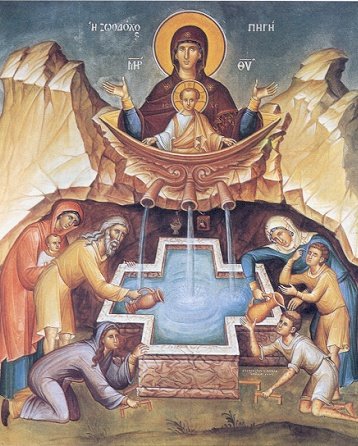Bright Friday
29 Απριλίου 2011

On Bright Friday, in addition to the normal Paskhal hymns and the hymns from the Octoechos, special stichera and a canon in honor of the Theotokos (Mother of God or Birthgiver of God) are chanted in commemoration of her Icon of the “Life-giving Spring.”
The Life-giving Spring or Life-giving Font is both the feast day of a historic church in Constantinople and an icon of the Theotokos (Virgin Mary) which is venerated by the Eastern Churches.
The tradition surrounding the feast concerns a soldier named Leo Marcellus, who would later become the Byzantine Emperor Leo I. On April 4, 480,[1] as Leo was passing by the grove, he came across a blind man who had become lost. Leo took pity on him, led him to the pathway, seated him in the shade and began to search for water to give the thirsty man. Leo heard a voice say to him, “Do not trouble yourself, Leo, to look for water elsewhere, it is right here!” Looking about, he could see no one, and neither could he see any water. Then he heard the voice again, “Leo, Emperor, go into the grove, take the water which you will find and give it to the thirsty man. Then take the mud [from the stream] and put it on the blind man’s eyes…. And build a temple [church] here … that all who come here will find answers to their petitions.” Leo did as he was told, and when the blind man’s eyes were anointed he regained his sight.
After he became emperor, Leo built a church dedicated to the Theotokos of the Life-giving Spring over the site where the spring was located.[2] After the Fall of Constantinople in 1453, the church was torn down by the Turks, and the stones used to build a mosque of Sultan Bayezid. Only a small chapel remained at the site of the church. Twenty-five steps led down to the site of the spring surrounded by railing. As a result of the Greek Revolution of 1821, even this little chapel was destroyed and the spring was left buried under the rubble.
In 1833 the reforming Ottoman Sultan Mahmud II gave permission for the Christians to rebuild the church. When the foundations of the original church were discovered during the course of construction, the Sultan issued a second firman permitting not only the reconstruction of the small chapel, but of a large church according to the original dimensions. Construction was completed on December 30, 1834, and theEcumenical Patriarch, Constantine II consecrated the church on February 2, 1835.
On September 6, 1955, the church was destroyed again by Moslems during a riot. Another small chapel has been rebuilt on the site, but the church has not yet been restored to its former size. The spring still flows to this day and is considered by the faithful to have wonderworking properties.
The feast day is observed on Bright Friday; i.e., the Friday following Paskha (Easter). It is the only feast day which may be celebrated during Bright Week, all other commemorations which happen to fall during this time are usually transferred to another day. The propers (hymns and prayers) of the feast are combined with the Paskhal hymns, and there is often a Lesser Blessing of Waters performed after the Divine Liturgy on Bright Friday.
Outside the Imperial City of Constantinople, near the Golden Gate (Porta Aurea) used to be found a grove of trees. There was located a shrine which from early times had been dedicated to the Theotokos and a spring of water. Over time, the grove became overgrown and the spring became fetid.
Apolytikion in the Third Tone
As a life-giving fount, thou didst conceive the Dew that is transcendent in essence, O Virgin Maid, and thou hast welled forth for our sakes the nectar of joy eternal, which doth pour forth from thy fount with the water that springeth up unto everlasting life in unending and mighty streams; wherein, taking delight, we all cry out: Rejoice, O thou Spring of life for all men.
Kontakion in the Plagal of the Fourth Tone
O Lady graced by God, you reward me by letting gush forth, beyond reason, the ever-flowing waters of your grace from your perpetual Spring. I entreat you, who bore the Logos, in a manner beyond comprehension, to refresh me in your grace that I may cry out, “Hail redemptive waters.”



